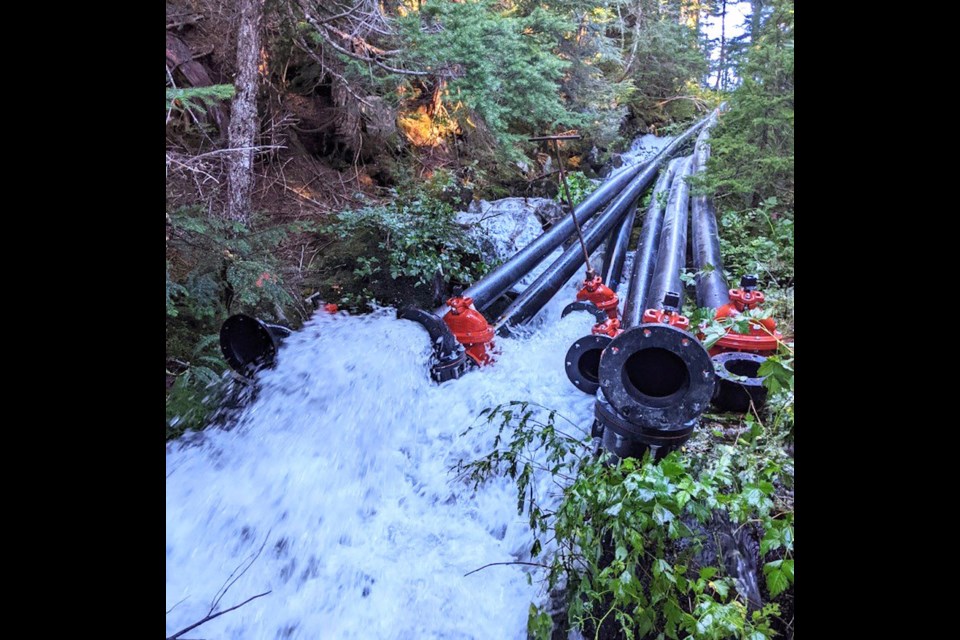As of mid-day on Oct. 5, siphons on Edwards Lake are set to start adding water to the Sunshine Coast Regional District’s (SCRD) Chapman water system.
Testing was successfully completed and with regulatory approvals in place, the SCRD’s manager of infrastructure services Remko Rosenboom says that means the community has guaranteed water supply until early November.
The installation was a “huge effort” on the part of SCRD staff according to Rosenboom who said personnel worked “extremely long days, from dawn to dusk,” to get the job done.
Siphoning water from Edwards adds about two and a half weeks of supply to the SCRD’s largest water system which serves most Coasters residing in areas from West Howe Sound to Halfmoon Bay. That system has been on Stage 4 water restrictions since Aug. 31 and the SCRD activated and Emergency Operations Centre Sept. 27 to manage the drought situation.
Rosenboom told Coast Reporter the water level at Chapman Lake, the system's primary source, is 466 centimetres below the top of the weir on the SCRD’s dam, which is far below any level that the SCRD has seen before.
All users on the system continue to be asked by the SCRD to conserve water to ensure supplies remain available. With Environment Canada predicting dry and warm weather for the upcoming two weeks, Rosenboom said there is a high likelihood it will continue to be dry until early November, bringing water supply levels in “too close for our comfort.”
Considering other supply options
“After Edwards, there are no defined, guaranteed supplies left. We are exploring if it would even be possible to draw down Chapman further with the use of pumps, but we are in the early phase of exploring if that is possible from a technical perspective and also need to engage with regulators, because that would mean that we would have pumps, fuel and generators stored in the [Tetrahedron Provincial] park. It is by far not a given that we will be able to get approval for that and it is a risk for the SCRD as well to have fuel sitting next to our main water source.”
The SCRD does not have the pumping equipment needed for that undertaking on hand. “Sourcing with suppliers is part of the preparation work that we are currently undertaking,” Rosenboom stated.
Other options to access more supplies for the Chapman system include trucking in water from other water systems on the Coast and bringing water in from off-Coast. “We are in the planning stage to explore all of those options but none of those decisions will be considered by the board until late October when we have a better understanding of how long the dry weather will continue,” he said.
The Town of Gibsons has been providing water to the Chapman system since Sept. 29. Rosenboom said that 300 cubic meters of water per day is coming in from that source. That equates to about three per cent of daily consumption on the system which continues to hover at around 10,000 cubic meters per day.
At this point, no further user restrictions are being contemplated, but he said “more could come later in October when we have a better picture about the drought’s continuation. A state of local emergency could be declared which would allow the SCRD to shut off water to high users or certain businesses… that is one of the things we are preparing for.”
Updating the public
A water update is slated to be on the agenda for the Oct. 13 board meeting. SCRD communications manager Aidan Buckley said that brief video messages on the water situation were being released on scrd.ca. He said that plans are to update those two to three times a week moving forward.
The SCRD is also “stepping up efforts to reduce leaks on water connections to properties and some of them are large and we are continuing to have those leaks fixed as soon as possible,” according to Rosenboom. “At the same time, we have identified a number of high water users that we are connecting with to make sure that they are fully aware of the situation and the need to reduce their consumption. We are also doing this towards businesses … It is not only residents; we need support from businesses and anybody else that can save some water because we really need it.”



